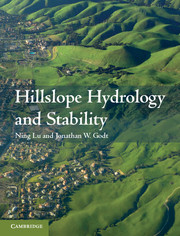Book contents
- Frontmatter
- Contents
- Foreword
- Preface
- List of Symbols
- PART I Introduction and state of the art
- PART II Hillslope hydrology
- Part III Total and effective stress in Hillslopes
- PART IV Hillslope Material properties
- PART V Hillslope stability
- 9 Failure surface based stability analysis
- 10 Stress field based stability analysis
- References
- Index
- Plate section
10 - Stress field based stability analysis
from PART V - Hillslope stability
Published online by Cambridge University Press: 05 February 2013
- Frontmatter
- Contents
- Foreword
- Preface
- List of Symbols
- PART I Introduction and state of the art
- PART II Hillslope hydrology
- Part III Total and effective stress in Hillslopes
- PART IV Hillslope Material properties
- PART V Hillslope stability
- 9 Failure surface based stability analysis
- 10 Stress field based stability analysis
- References
- Index
- Plate section
Summary
Failure modes in hillslopes
Slope stability analyses based on known or assumed rupture geometry prevail in the civil design of foundations and other earth structures. However, several inherent limitations impede the application of these approaches for prediction of rainfall-induced landslides in natural settings. Importantly, further theoretical development to assess landslide initiation and progression is also constrained by these limitations. The major limitations are: simplification of the geometry and location of the landslide failure surface, and simplification of the treatment of variably saturated flow and stress conditions. In recent years, some efforts have been made in overcoming these limitations, yet frameworks that are ready for practical applications remain to be established. This chapter attempts to provide a framework to move beyond both limitations.
Simplification of the geometry and location of failure surfaces was an effective, powerful, and necessary strategy for slope stability analysis prior to the widespread availability of computational tools that provide a means to quantitatively simulate the stress distribution in hillslopes. The assumption that all points along a pre-defined failure surface simultaneously reach a limiting equilibrium state greatly simplifies computational procedures and leads to single, consistent stability indicator or factor of safety (FS) for the entire slope. In reality, the state of stress along a pre-defined failure surface or any surface in a hillslope varies from point to point, and catastrophic failure is likely the result of progressive failure within a hillslope. As described in Chapters 5 and 7, the failure modes of hillslope materials are primarily shear and tensile. For example, consider the total stress field that results from gravity and geologic history shown in Figure 10.1. At point A, near the crest of the slope, the distribution of total stress promotes tensile failure, whereas for the middle of the slope (shown as point B) and near the toe (shown as point C), the distribution of total stress favors shear failure. It is unlikely that all these points along a potential rupture surface will fail simultaneously. Depending on the geologic and geomorphic factors that control the stress history of the hillslope, a failure that initiates in some part of the slope and then propagates is a likely scenario.
- Type
- Chapter
- Information
- Hillslope Hydrology and Stability , pp. 364 - 405Publisher: Cambridge University PressPrint publication year: 2013



